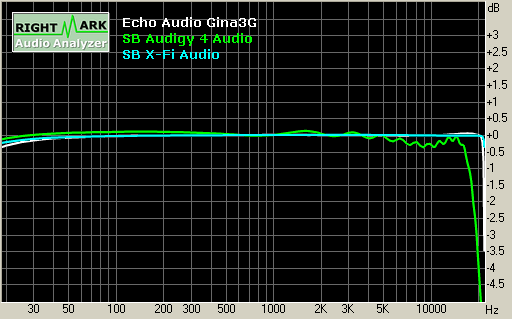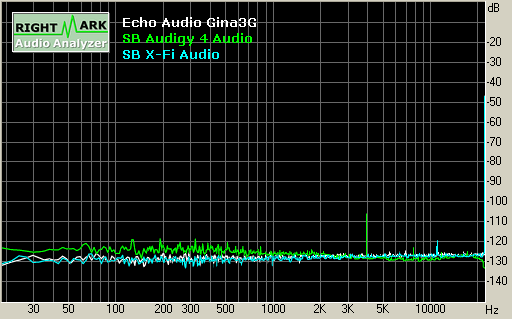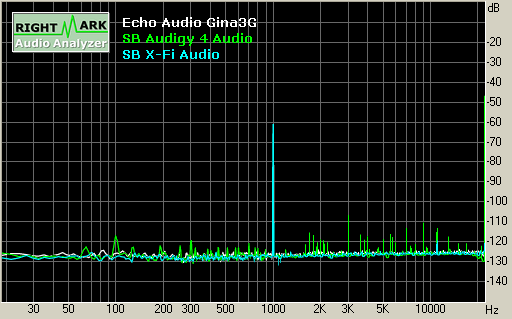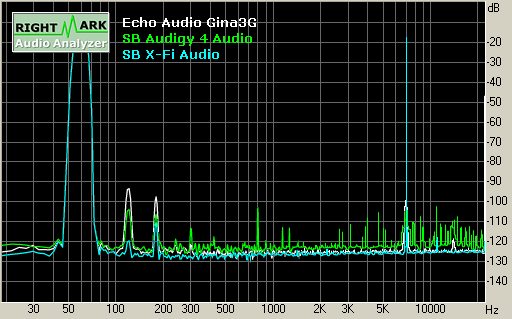X-Fi and the Elite Pro: SoundBlaster's Return to Greatness
by Derek Wilson on August 30, 2005 11:59 AM EST- Posted in
- Smartphones
- Mobile
Quantitative Analysis: RMAA 16-bit / 44.1 kHz
RightMark Audio Analyzer is the best tool that we have right now for determining solid numbers that describe the precision and capabilities of sound hardware in our labs. We are able to measure many of the interesting electrical characteristics of the hardware by running RMAA, which captures the output of a sound card playing a test file and analyses the recording. Unfortunately, the electrical characteristics of the recording hardware come into play when using RightMark. By using quality recording equipment, we can still get a very good idea of the hardware's capabilities. For a more in-depth look at what we are looking for in our RMAA tests, check out this page on our electrical analysis of sound hardware.The best way to see what's going on is to dive into the numbers.
| Test | Echo Audio Gina3G | SB Audigy 4 Audio | SB X-Fi Audio |
| Frequency response (from 40 Hz to 15 kHz), dB: | +0.04, -0.09 | +0.13, -0.36 | +0.01, -0.07 |
| Noise level, dB (A): | -94.3 | -94.5 | -94.7 |
| Dynamic range, dB (A): | 94.1 | 94.1 | 94.6 |
| THD, %: | 0.0057 | 0.0033 | 0.0008 |
| IMD + Noise, %: | 0.0079 | 0.0081 | 0.0054 |
| Stereo crosstalk, dB: | -94.9 | -93.3 | -97.0 |
Frequency response of the X-Fi is much better at 16-bit 44.1 kHz than the Audigy. In fact, we can see that the frequency response curve is even flatter than the Gina 3G here. The SoundBlaster X-Fi Elite Pro posts better numbers any card we've yet tested in our labs at this very heavily used bitrate.
When looking at the graphs, note that the X-Fi is able to post these numbers while maintaining consistant performance in each test. The only tradeoff we see is in stereo cross-talk, which just shows a trade off at high frequencies rather than low.

Frequency Response

Noise Level

Dynamic Range

THD+N at -3dB FS

Intermodulation Distortion

Stereo Crosstalk










110 Comments
View All Comments
Reflex - Wednesday, August 31, 2005 - link
Derek, please read the following http://www.microsoft.com/whdc/device/audio/uaa.msp...">article on Universal Audio Architecture. Between that and Intel's HD Audio spec, all the supposed benefits of the X-Fi driver architecture are achieved already, and in a standard fashion that other sound card manufacturers can follow. There is nothing unique about what Creative is offering, only the marketing surrounding it, and in fact its been on the market since Intel's HD Audio first came out.Multiple source/multiple channel audio is definatly a major application in the future, but Creative is not the company leading the charge on this, only following suit.
Once again I feel that your article in its present state serves as an advertisement rather than an objective analysis. I am certain that was not the intention, however due to the lack of research it came out that way anyways.
HardwareD00d - Wednesday, August 31, 2005 - link
Thanks for your post. I was thinking I'd upgrade from my Audigy2 to an X-Fi, but now I think I'll pass.PenGun - Tuesday, August 30, 2005 - link
Could not have put it better, thanks.PenGun
monsoon - Tuesday, August 30, 2005 - link
guys, i'm looking for an HTPC config with dual-core AMD where i can use the opticl drive without turning on the PC......i know, seems a bit out of context; but if this card or any lesser ( ? ) can be used in such context, what product would you recommend ?
i like the HP DEC form factor, but i'll take anything proven worthy WITH AMD DUAL CORE and and an optical drive independent from PC.
thanks for feedback,
cordially,
a.
Calin - Wednesday, August 31, 2005 - link
The ASUS boards have the capability to play audio CDs from BIOS (I remember something like that, I don't have the ASUS board/manual to check). Maybe if you start the CD it will play while your computer is stopped?whymeintrouble - Tuesday, August 30, 2005 - link
I believe HP has a media center pc that can run a dvd drive, but not need to be in windows to use it. I don't know if it has the option of the Dual Core X2s though.I want to see a few more reviews go up before I make my judgements on these cards.
RussG - Tuesday, August 30, 2005 - link
This still won't make myself, and a lot of people, upgrade from onboard sound. What I would like to see is more comparisons of how this is going to affect my FPS in more then 1 game, and how it stacks up to common on board solutions. They bring out all of this marketing because realities are not many people care about sound greater then onboard, and with no game support or evidence of existing game improvement there is little reason to pick this up.NeonFlak - Tuesday, August 30, 2005 - link
I bought the $130 X-Fi last night at bestbuy. I haven't seen this mentioned anywhere but compared to all my other sound cards, including onboard sound, when listening to MP3s or any other sound format it is very muffled unless the crystalizer is turned on. But, just as the review says the crystalizer doesn't really work well with everything.Games sound fine though. I haven't tested any movies since I don't watch movies on my pc.
DerekWilson - Tuesday, August 30, 2005 - link
Are you sure you don't have CMSS-3D turned on? I find that sound can get very muffled and muddied when playing music using CMSS-3D ... That could be your problem.Our experience is that the sound quality with no filtering is better on the X-Fi than most other solutions. Of course, we do still need to look at the XtremeMusic card.
knitecrow - Tuesday, August 30, 2005 - link
Ok, SoundBlaster is the only game when it comes to games... but what about listening to music or watching DVDs?Does it sound any better than my $30 chaintech VIA ENVY24 card or M-audio Revolution? I would like to see some blind listening tests.
You have many many software based solutions that claim to make mp3s and other lossy formats sound better, for example SRS WOW effects that come bundled with Windows Media Player or Qsound. Is the creative crystallizer any better when compared to such software solutions?